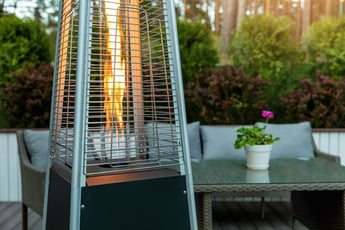
March is here. Yes, it’s still cold. Yes, COVID-19 is still present. What does this mean? It’s not ideal to be outdoors, or in COVID-19 terms, indoors for that matter, in the winter months. Outdoor dining and socially distanced gatherings nowadays are a large part of our everyday lives. People remain hesitant to eat indoors. For many places to survive during the winter months, they needed to come up with a resolution to keep people coming in. Thanks to those handy dandy portable propane heaters, they did just that by converting outdoor space into usable space to ensure their patrons continued visiting.
COVID-19 tossed a wrench into a lot of people’s and business’s winter plans. Outdoor spaces that were not intended to be gathering spots became just that. And many of these outdoor spaces were not ideal for utilizing portable propane heaters.
Portable propane heaters are attractive and warm and really seem like a great idea at the time of purchase, but let’s not get ahead of ourselves. These heaters come with a list of fire and safety hazards you need to consider before investing and implementing them into your outdoor space at home or at your business.
If you’re considering buying or currently use portable propane heaters for personal or business use, it’s essential the following tips are practiced to ensure the safety of structures and lives.
Safety Features
Almost all portable heaters are made with the consumer in mind. And consumer safety is at the top. Propane heaters feature a wide variety of safety features that are intended to prevent fires or injuries.
One safety feature to look for is an anti-tilt device. This inhibits any tilting of the upright stand keeping the propane tank level. An example of an anti-tilt feature is a wide base, which minimizes tipping. If you’re willing to spend money, the high-end models feature a mechanism that shuts off the flame when it senses the heater may be falling or tilting.
Do you know what a thermocouple is and does? You want to if you’re purchasing a portable propane heater. A thermocouple is a flame failure device. It cuts off the gas in the event the flame blows out. This alleviates the risk of a gas leak.
Proper Use
Portable propane heaters are for outdoor use only. Placement is key. They should be kept at least three feet away from anything that may catch fire and should not be used in a confined space or under a tent. Depending on the surrounding structures, placement may need to be further than three feet. Portable propane heaters don’t tend to radiate heat a long distance so keeping them away from combustible items is essential to steer clear of a fire hazard. Some combustible items to keep in mind are outdoor grass, certain potted plants, and even lighter fluid if spilled or left out. You never want to place these heaters on grass – a sturdy, stable surface is the way to go.
When using a propane heater, it’s important to close the gas valve when not in use. This can make the tank last longer and preserve quality, which is ideal when handling propane. Anytime you switch out propane tanks you need to check the valves and hoses for leaks before filling up.
Remember the anti-tilt device mentioned above? It also comes into play with proper use. These heaters are made to be tall, which enables them to topple more often if not used on a sturdy surface. It’s important to secure and stabilize the heaters as best as possible. There are many precautions you can take to prevent tilting or toppling. You can weight the heater down with sandbags or water weights as long as they are water-resistant materials. Flame-retardant ties are also an option. Whatever option you choose, be sure to follow standard fire safety protocol.
You never want to move a heater while it’s on and the flame is open. This can disturb the flow of gas and create more issues with the hose potentially causing leaks. You also never want your customers or someone not familiar with these heaters to be able to move them. They are heavy and more harm than good can be done if someone unfamiliar with the device attempts to move it.
Storage and Protection
Portable propane heaters create a great ambience while keeping you warm during the colder days and evenings. When it comes to the weather, it's important to provide the necessary care to keep the heater in best shape. Most heaters have a weather-resistant coating for rain or snow, but for wind? That’s a breeze to address. Wind can easily and quickly do more damage than good with a propane heater. Depending on the size of the heater, wind can easily knock it over if not secured. Keeping in mind the placement and safety standards, a heater that is less exposed on the windier side of a structure will be less likely to have these issues.
Most storage areas offer a dry environment, which can do more harm than good. Storing your heater in a dry space can lead to cracks in hoses or rust throughout the product. Like most winter items kept in storage during those hotter months, cobwebs and dirt tend to pile up and accumulate creating a filthy mess. Taking a few simple steps – disassembly, cleaning, reassembly, replace - can help prevent a number of issues when it comes to storing your heater when not in use.
With any product, it’s important to read and follow the manufacturer’s instructions and tips. Outdoor portable propane heaters are no different. While they provide a wonderful atmosphere, the risks are even greater. Safety is the most important aspect to remember when using an outdoor portable propane heater. Take the fire safety precautions seriously, and enjoy the cooler evenings outdoors.
For more information about outdoor heater safety and equipment, visit the NFPA Outdoor Heater Fact Sheet.

